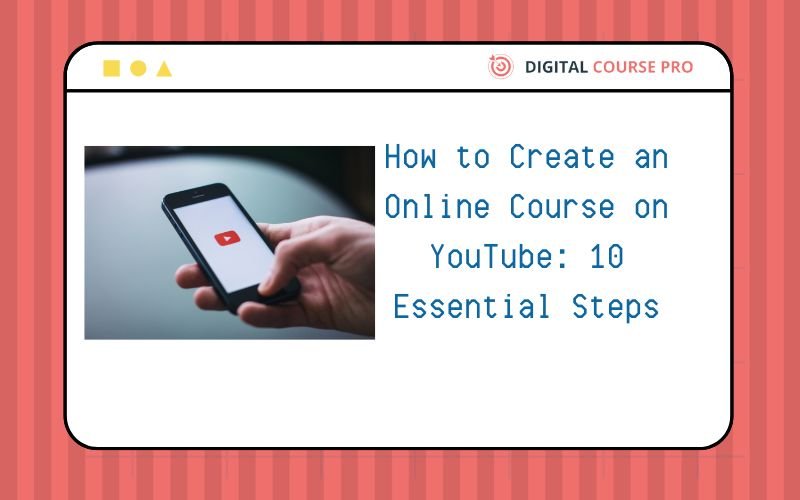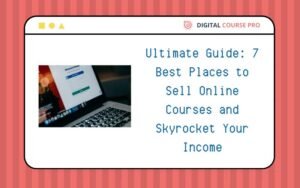Create an online course on YouTube to reach a global audience. Creating an online course on YouTube has become a powerful way to share knowledge and engage with a global audience. From crafting compelling content to leveraging YouTube’s vast reach, the process offers immense opportunities for educators and experts alike. Whether you’re new to online teaching or looking to enhance your current offerings, understanding how to effectively harness YouTube’s platform is key to reaching and impacting your audience effectively. This guide explores essential steps and strategies to help you create and promote your online course on YouTube successfully.

1. Choose Your Course Topic
Selecting the right topic for your online course is crucial as it forms the foundation of your content. Start by identifying your expertise and passion areas. Consider what knowledge or skills you can effectively teach and what topics resonate with your target audience. Conduct market research to validate your course idea, ensuring there is demand and interest. Analyze competitors to identify gaps or unique angles you can offer. Ultimately, choose a topic that you are passionate about, have expertise in, and that meets the needs of your potential students. This thoughtful selection will set the stage for creating a valuable and engaging online course on YouTube.
2. Define Your Course Structure
Once you have chosen your course topic, the next step is to define a clear and logical structure for your online course on YouTube. Start by outlining the main modules or sections that will guide your students through the learning journey. Break down each module into smaller lessons or topics to ensure a cohesive flow of information. Consider the best sequence for presenting the content to facilitate learning progression.
Organize your course structure in a way that is easy to navigate and understand for your audience. Include introductory and concluding sections for each module to provide context and reinforce key takeaways. A well-defined structure not only helps in organizing your content effectively but also enhances the learning experience for your students on YouTube.
3. Plan Content and create an online Course on YouTube
Planning your content is essential to creating a cohesive and engaging online course on YouTube. Start by outlining the key concepts and learning objectives you want to cover in each lesson or module. Consider the best format for delivering your content, whether through video lectures, demonstrations, screen sharing, or a combination.
Create a detailed script or outline for each video to ensure clarity and coherence. Include visuals, examples, and practical exercises to enhance understanding and retention. Plan for interactive elements such as quizzes, assignments, or discussions to encourage active learning and engagement.
Moreover, consider the pacing and duration of your videos to maintain viewer interest and accommodate different learning styles. A well-thought-out content plan not only helps you stay organized but also ensures that your course delivers value and effectively conveys your expertise on YouTube.
4. Set Up Your YouTube Channel
Setting up your YouTube channel is crucial for hosting and delivering your online course effectively. Start by creating a YouTube account if you haven’t already. Customize your channel name, profile picture, and banner to reflect your brand or course theme.
Next, optimize your channel description and about section to clearly communicate what your course offers and who it’s for. Enable channel features like playlists, which will help organize your course videos into logical sequences for your viewers.
Additionally, familiarize yourself with YouTube’s analytics and video management tools. These tools will help you track viewer engagement, demographics, and other metrics that can inform your content strategy and improve your course over time.
Lastly, consider branding elements such as channel trailers or introductory videos to introduce visitors to your course content and encourage them to subscribe for updates. Setting up your YouTube channel thoughtfully will enhance the visibility and accessibility of your online course, ultimately supporting its success.
5. Create High-Quality Video Content
Creating high-quality video content is essential to engaging your audience and delivering valuable lessons effectively on YouTube. Start by investing in a good quality camera, microphone, and lighting setup to ensure clear visuals and audio.
Plan your filming environment to minimize distractions and ensure a professional appearance. Script your videos or create detailed outlines to maintain focus and coherence throughout each lesson.
During filming, speak clearly and confidently, maintaining eye contact with the camera to establish a connection with your viewers. Incorporate visual aids such as slides, graphics, or demonstrations to enhance understanding and engagement.
After filming, edit your videos using editing software to refine your content, add transitions, and improve overall production quality. Pay attention to pacing, ensuring your videos are informative yet engaging.
Creating high-quality video content not only enhances the learning experience but also reflects positively on your brand and credibility as an instructor on YouTube.
6. Upload and Organize Videos
Once you have created your high-quality video content, the next step is to upload and organize them effectively on your YouTube channel. Start by logging into your YouTube account and accessing the YouTube Studio dashboard.
Upload your videos by clicking on the “Create” button and selecting “Upload Videos.” Follow the prompts to select your video file, add a title, description, and relevant tags to optimize searchability.
Organize your videos into playlists to make it easier for viewers to navigate through your course content. Create playlists based on modules, topics, or chronological order to provide a structured learning experience.
Use YouTube’s customization options to set video thumbnails, add end screens, and cards to promote other videos or encourage viewer interaction.
Lastly, review your video settings to ensure they are optimized for viewer engagement, including enabling comments and adjusting privacy settings as needed.
Organizing and uploading your videos systematically not only enhances the user experience but also helps in managing and promoting your online course effectively on YouTube.
7. Engage with Your Audience
Engaging with your audience is crucial for fostering a vibrant community around your online course on YouTube. Start by responding promptly to comments and questions on your videos. Show appreciation for feedback and encourage further discussion by asking questions or prompting viewers to share their thoughts.
Host live streams or Q&A sessions to interact with your audience in real-time, addressing their queries and providing additional insights. Encourage viewers to subscribe to your channel and turn on notifications to stay updated on new content and live events.
Create community posts to share updates, behind-the-scenes insights, or additional resources related to your course. Encourage interaction by asking for feedback or inviting viewers to participate in polls or discussions.
Additionally, collaborate with other content creators or industry experts to expand your reach and provide diverse perspectives on relevant topics. Responding to audience engagement not only builds trust and loyalty but also enhances the overall learning experience and success of your online course on YouTube.
8. Use YouTube Analytics
Utilizing YouTube Analytics is essential for understanding your audience’s behavior and optimizing your online course effectively. Start by accessing YouTube Studio and navigating to the Analytics tab. Here, you can gain insights into viewer demographics, watch time, and traffic sources.
Track key metrics such as viewer retention, which shows how long viewers are watching your videos before dropping off. Use this data to identify engaging content and areas for improvement in your course.
Monitor engagement metrics like likes, comments, and shares to gauge viewer interaction and adjust your content strategy accordingly. Analyze traffic sources to understand how viewers discover your videos and optimize promotion efforts.
Utilize the audience retention graph to pinpoint specific moments in your videos where viewers are losing interest. Adjust pacing, content delivery, or visuals to maintain engagement throughout your course.
Regularly review YouTube Analytics to measure the effectiveness of your strategies and make informed decisions to enhance the quality and impact of your online course on YouTube.
9. Monetize Your Course
Monetizing your course on YouTube can be a rewarding way to generate income from your expertise and effort. Start by joining the YouTube Partner Program (YPP) and meeting the eligibility criteria, which include having 4,000 watch hours in the past 12 months and 1,000 subscribers.
Once accepted into YPP, enable monetization on your channel and videos by setting up Google AdSense. This allows ads to be displayed before, during, or after your videos, providing revenue based on viewer interactions.
Consider additional monetization options such as channel memberships, where viewers pay a monthly fee for exclusive perks like badges, emojis, and members-only content. You can also promote merchandise or affiliate products related to your course in video descriptions or through YouTube’s merchandise shelf feature.
Explore crowdfunding platforms like Patreon or Ko-fi, where fans can support you directly through donations or subscriptions for bonus content or personalized rewards.
Lastly, leverage YouTube’s sponsorship opportunities or brand collaborations to secure partnerships with companies interested in reaching your audience.
By strategically monetizing your course on YouTube, you can turn your passion into a sustainable income stream while continuing to provide valuable content and insights to your viewers.
10. Promote Your Course
Promoting your course effectively on YouTube is crucial to reaching a wider audience and maximizing enrollments. Start by optimizing your video titles, descriptions, and tags with relevant keywords to improve search visibility.
Utilize YouTube’s SEO features such as video thumbnails, end screens, and cards to encourage viewers to explore more of your content and subscribe to your channel.
Promote your course across social media platforms like Facebook, Twitter, and Instagram to reach different audience segments and drive traffic to your YouTube channel.
Interested in mastering social media advertising to boost enrollment for your digital courses? Dive deeper into “Mastering Social Media Advertising for Digital Course Creators: 10 Essential Strategies to Boost Enrollment” to discover actionable insights and proven techniques. Learn how to optimize your advertising efforts across platforms like Facebook, Instagram, and more to attract and convert your ideal audience. Whether you’re new to digital course creation or looking to refine your marketing approach, this guide offers invaluable tips to enhance your advertising strategy and drive enrollment growth. Read more and elevate your digital course marketing game today!
Collaborate with influencers or industry experts to leverage their reach and credibility in promoting your course to their followers.
Create teaser videos or trailers that highlight the benefits and key features of your course, enticing viewers to learn more and enroll.
Consider running YouTube ads or Google Ads campaigns to target specific demographics or interests related to your course topic.
Engage with your audience through community posts, live streams, or Q&A sessions to build rapport and encourage enrollment.
Monitor your promotional efforts using YouTube Analytics to track performance metrics such as traffic sources, viewer engagement, and conversion rates. Adjust your strategies based on data insights to optimize promotion and achieve your enrollment goals.
By implementing a comprehensive promotion strategy, you can effectively showcase your course on YouTube and attract motivated learners eager to benefit from your expertise.
Here are five YouTube channels that offer valuable examples and insights for digital course creators:
- Udemy
- Udemy’s YouTube channel provides tips for instructors on creating and promoting courses, as well as success stories from course creators.
- Teachable
- Teachable’s channel offers tutorials and strategies on creating and marketing online courses, along with insights into course creation tools.
- Skillshare
- Skillshare’s YouTube channel features interviews with successful teachers, course creation tips, and advice on growing a following on the platform.
- CreativeLive
- CreativeLive’s channel focuses on creative skills and entrepreneurship, offering behind-the-scenes looks at course creation and live workshops.
- HubSpot Academy
- HubSpot Academy’s channel provides marketing and sales training, showcasing how digital courses can be effectively marketed and monetized.
These channels serve as excellent resources for digital course creators, offering inspiration, practical advice, and strategies to succeed in the online education space.
Summary
In summary, creating an online course using YouTube involves meticulously planning your content, engaging with your audience, and leveraging YouTube’s powerful tools for promotion and monetization. Begin by selecting a compelling course topic and structuring your content in a way that guides learners through a meaningful learning journey. Utilize high-quality video production techniques to ensure clarity and engagement.
Organize your videos effectively on your YouTube channel, optimizing them for search and viewer retention. Engage actively with your audience through comments, live sessions, and community posts to foster a supportive learning environment. Monitor your course’s performance using YouTube Analytics to refine your strategies and maximize impact. Finally, explore various monetization avenues such as ads, memberships, and collaborations to generate revenue while delivering value to your students. By following these steps, you can create a successful online course on YouTube that attracts, engages, and educates a global audience.





